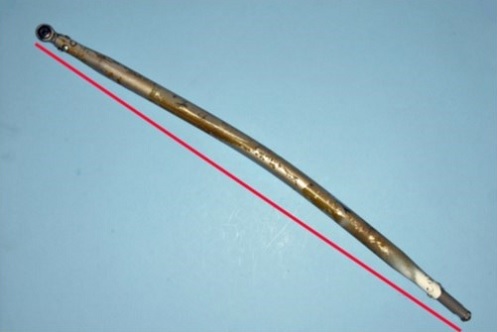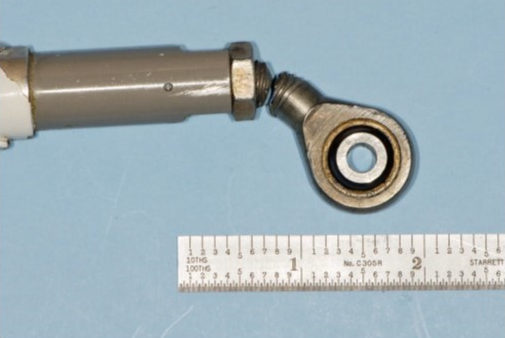Attention:
Owners, operators and maintainers of general aviation aeroplanes
| File Classification No.: | Z 5000-35 |
|---|---|
| RDIMS No.: | 16486355 |
| Document No.: | CASA 2020-12 |
| Issue No.: | 01 |
| Effective Date: | 2020-10-23 |
Purpose:
The purpose of this Civil Aviation Safety Alert (CASA) is to raise awareness of the potential for damage to components of flight control systems if an aeroplane is exposed to strong winds, and to recommend corrective actions in the event of such exposure.
Background:
A DHC-3 Otter aeroplane was stored outdoors and exposed to a 2-day blizzard with 27 knot winds. On the day following the end of the blizzard, the pilots went to prepare the aircraft for a flight. When they arrived at the aircraft, they observed that the auxiliary control lock that they had installed on the elevator had fallen to the ground and the elevator was in the down position. The control lock that was installed in the cockpit was still in place. An inspection panel in the tail was opened and it was found that the elevator connecting rod assembly was bent and broken (see Figures below). Failure examination of the connecting rod found that there were no pre-existing conditions such as corrosion or fatigue cracking that contributed to the event.
Transport Canada Airworthiness Directive (AD) CF-85-04 includes a requirement to inspect this DHC-3 elevator connecting rod (called a pushrod in the AD) and attaching hardware whenever a parked aircraft has been exposed to jet or helicopter blast or winds with an estimated mean velocity of 55 km/h (30 knots) with gusting winds up to 100 km/h (54 knots). Since the reported wind speed during the blizzard was less than the average wind speed that is the threshold to trigger the AD CF-85-04 inspection, it was not strictly necessary to accomplish the inspection required by the AD. It is fortunate that, in the occurrence described above, the connecting rod fractured and the elevator was out of its normal position: the pilots were presented with obvious indications of a problem with the elevator control system and their further investigation was prudent. If the connecting rod had been severely damaged but not fractured, it is likely that the damage would not have been detected and possible that it would have failed during a subsequent flight. Loss of elevator control will usually render the aeroplane uncontrollable with catastrophic consequences.
It is not clear whether the actual conditions experienced by the occurrence aircraft were more severe than those observed/reported or if the AD CF-85-04 thresholds for performing the ‘strong winds’ conditional inspection are not sufficiently conservative.
The DHC-3 is not unique in its vulnerability to damage from strong winds. The Instructions for Continuing Airworthiness (ICA), which includes Maintenance Manuals, etc. for many general aviation and commercial transport aeroplanes, include conditional inspections such as the one in AD CF-85-04. The absence of this type of conditional inspection in the ICA does not mean that a particular model of aeroplane is immune to the effects of strong winds, jet blast or helicopter downwash. The Canadian Aviation Regulations (CARs), Standard 625 Appendix G Section (15) provides instructions for inspecting aircraft after they have been exposed to high winds or jet blast.
For more information on the general topic of Flight Control Protection from Damage by Strong Winds please consider reading the SKYbrary Aviation Safety article with that title; it is available at https://www.skybrary.aero/index.php/Flight_Control_Protection_from_Damage_by_Strong_Winds. Note that the article is focused on transport category aeroplanes but contains information that is beneficial to the general aviation sector as well.
Figures
Recommended action:
- Always secure the flight controls with suitable locks if an aeroplane will be left unattended.
- During pre-flight inspection, be vigilant for any indication that the aeroplane has been exposed to strong winds, including displaced control locks, damaged flight control surfaces / components / attaching hardware. If it is suspected that such exposure has occurred, inspect the aircraft in accordance with CARs Standard 625 Appendix G and, if available, the manufacturer’s instructions. A straight-edged tool may be useful to help detect distortion of components such as connecting rods that should be straight or flat.
- Do not assume that the specified thresholds for a ‘strong wind’ conditional inspection are conservative. Local phenomena such as gusts from mechanical turbulence on the lee side of buildings or terrain features may produce much stronger winds than those observed and reported by aviation weather services.
- Jet blast and propeller wash from passing fixed wing aeroplanes and downwash from passing helicopters are just as capable of causing damage to general aviation aircraft as ‘naturally occurring’ winds and such locally-generated winds will not be detected or reported by aviation weather services. Be vigilant for indications of strong locally-generated winds even if you know your aeroplane has not been exposed to strong naturally-occurring winds. These indications can include such things as landing gear wheels that have ‘jumped’ their chocks, displaced control locks or missing windshield, engine intake, propeller or pitot tube covers.
Contact office:
For more information concerning this issue, contact a Transport Canada Centre; or contact Ross McGowan, Continuing Airworthiness in Ottawa, by telephone at 1-888-663-3639, facsimile at 613-996-9178 or e-mail at cawwebfeedback@tc.gc.ca.
Original signed by
Rémy Knoerr
Chief, Continuing Airworthiness
National Aircraft Certification
The Transport Canada Civil Aviation Safety Alert (CASA) is used to convey important safety information and contains recommended action items. The CASA strives to assist the aviation industry's efforts to provide a service with the highest possible degree of safety. The information contained herein is often critical and must be conveyed to the appropriate office in a timely manner. The CASA may be changed or amended should new information become available.
Flight Control Protection from Damage by Strong Winds
(PDF, 120 KB)



